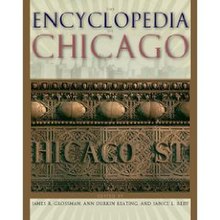History
Inspired by encyclopedia compilation efforts of cities such as New York City, Indianapolis and Cleveland, Keating approached the Newberry Library in 1991 to strategize on how to best to study and teach Chicago history. Eventually she and Grossman agreed to prepare a funding request from the National Endowment for the Humanities (NEH). Their initial proposal was declined, but after working with Grossman to refine the specifics of their proposal, the NEH accepted their idea. [5] [10] The book venture was originally announced in 1994 as a project funded by a NEH US$200,000 ($411,136 today) grant. [11] The grant also included a $300,000 challenge grant to be met by Newberry Library for the first three years of work. [5] The original plan was to publish a hardcover book by 2001 and then to follow with what at the time was referred to vaguely as "hypermedia" in reference to possible internet and CD-ROM auxiliary products. [11] After Grossman and Keating obtained the initial grant, Reiff, a historian with computer expertise, and encyclopedia veteran Carol J. Summerfield all became part of the team. [5] The editors sought the advice of Chicago-area librarians who were organized into focus groups to determine the proper components for the planned publication. The editors also organized into task forces of experts in dozens of specialized fields. [10] Early on they sought the expertise of University of Chicago cartographer Michael P. Conzen, who helped develop 56 original maps. [10] Conzen is credited as the cartographic editor. [1]
By 1997, the text had taken shape and the plan was that the average biographical entry would be 150 words. The longest biographical entries, about 450 words, were written for former Chicago Mayors Harold Washington and Richard J. Daley. Neither Richard M. Daley nor Michael Jordan had entries because only notable deceased persons were included. [7] By 1998, the editors had settled on the table of contents and begun the job of assigning, editing, fact-checking and re-editing the hundreds of entries, some of them as long as 4000 words. [10] By March 2000, 1100 of the targeted 1400 entries were completed. Also, the growth of the internet had clarified the vision of an online version of the print edition. In 2000, the final volume was expected to be 1300 pages set for release in fall 2002. The internet version was expected the following year. [9] By June 2001, nearly 1300 of the entries had been submitted and a third had been edited and reviewed for accuracy. The effort had become a $2.5 million effort and was aspiring towards the success of earlier encyclopedic efforts projecting a fall 2003 publication of a 1.3-million-word 1300-page edition. At this time, the final electronic form available through the Chicago Historical Society had been conceptualized. [12]
Public release
By 2001, two editions of The Encyclopedia of Cleveland History (1987) had sold 24,000 copies; The Encyclopedia of Indianapolis (1994) had sold 9000 copies and The Encyclopedia of New York City (1995) had sold 70,000 (50,000 in its first year). Hardcover versions of these works had sold for $59.95 and up. The commercial success of these other regional encyclopedias made it clear that there is a market for such products. [12] Several university presses released regional encyclopedic publications in 2004. In April, Rutgers University Press published The Encyclopedia of New Jersey . In September, the University of Nebraska Press published Encyclopedia of the Great Plains. In October, the University of Chicago Press released The Encyclopedia of Chicago. Additionally, Yale University Press was scheduled to publish both Encyclopedia of New England and the second edition of The Encyclopedia of New York City. [13]
Using press releases from the Copley News Service, [14] [15] the book was widely publicized throughout the state of Illinois, [16] [17] and it was even reviewed by The Wall Street Journal . [18] When first published in 2004, the book was on the USA Today recommended Christmas gifts list. [19] That year it was at the top of the Chicago area bestseller lists at bookstores during the Christmas holiday season. [20] [21] Major funding for the $65 list price four-color print version of the publication, which cost $1.7 million in the end, was provided by the NEH, the MacArthur Foundation, the City of Chicago and the State of Illinois. [10]
Electronic edition
At the time of the print release, the online version, known as the Electronic Encyclopedia of Chicago, was being developed to include additional features, which relied on hyperlinks, that were not available in the print edition. [10] At the time, it was expected to be released by the Chicago Historical Society in April 2005. [2] On May 11, the Electronic edition, which cost nearly $1 million to create and is continuously available for free to the public, was released. It included hundreds of additional entries (bringing the total to 1766), [4] more than 1000 additional images, [22] video of historic figures and events, and extensive primary source material. [22] The online version includes 1000 more sources than the print edition. [4] The Web site includes many tables and maps that date to the 19th Century. [4] Northwestern University media specialists developed the Web architecture for the electronic version. [22] The electronic edition made Chicago the second major U.S. city (following Cleveland) with an extensive Internet encyclopedia dedicated to its history and its release was covered by newspapers throughout the Midwest. [23] [24] The extra features of the online edition would have required 10,000 pages to produce in print-edition format. [22] Initially, the online edition was a static version, but updates and adjustments were planned. [4]
Critical review
USA Today referred to it as a good coffee table book. [19] Chicago Tribune journalist Rick Kogan describes this as a massive undertaking with the natural foibles of the human element in it selections and accuracy, and by nature of its attempt to serve as a historical compilation an immediately dated product due to the dynamic nature of the city. However, he feels it is sure to amaze its audience. [6] A Chicago Sun-Times reviewer describes it as a scholarly product that is "easily the most comprehensive reference book on the Chicago region ever published". [10] The State Journal-Register , the Springfield, Illinois newspaper, reviewers complain that downstate cities and regions are neglected in the book. [16] A Daily Herald review describes it as a book accurately "billed as the city's most definitive historical reference book". [25] The Peoria Journal Star notes that although there are complaints about omissions and underserved topics, the online version should quell the demands for further knowledge. [17]
The online version was noted for its "large number of tables and maps that date to the 19th Century" by the Chicago Tribune . [4] Dubuque, Iowa's Telegraph Herald newspaper and Indiana's Post-Tribune referenced an Associated Press press release that described the online version as a compilation assembled "with more than Chicagoans in mind". [23] [24] The Chicago Tribune described the online version as an extension of "the most comprehensive reference book on the Chicago region ever published" that is unlimited by physical bounds. [22]
Journal of American History along with the website History Matters: The U.S. Survey Course on the Web published a review by University of Southern California professor Philip J. Ethington that spoke glowingly about both versions of the encyclopedia describing it as "one of the finest collective works (with 633 listed authors) of North American historical scholarship of our era". They praised it for its breadth and coherence. The online version was noted for its meticulous hyperlinking. The online review was cursory in the sense that it did not realize the expansion of the online version. However, the review notes that the online version provides "powerful and substantive" interactive resources that are not possible in the print edition. The review is especially respectful of the cartographic contributions, which it describes in detail. It dismisses the alphabetical structure of the online version as an unnecessary complication. The review also complains about biographical omissions that necessitate extensive navigation to related articles. The review felt some of the online foibles left open the possibility that the production might get overshadowed by future ventures that leverage the electronic possibilities more fully. [26]
The Chronicle of Higher Education reviewed the Encyclopedia along with several of its peers and mentioned early in the review that the advent of online encyclopedias makes the works much easier to correct and update. However, the availability of online encyclopedias diminished the significance of the print editions according to the review because it made gifting them less significant and it reduced sales at libraries. The review also noted that the online approach is becoming so successful that the state of Georgia has produced the online-only New Georgia Encyclopedia , which started as a 300-article venture and has blossomed to a 1300-article work. However, they noted that when the Encyclopedia of Chicago was first released that the local media supported the book; some Chicago disc jockeys read passages from it on air. It enjoyed successful marketing as both a popular gift item and a must-have for local historians. [27]
Content
The encyclopedia is composed of 1117 pages that feature over 1400 entries by more than 600 contributors. [10] Additionally, it includes 442 maps, more than 400 vintage photographs, [25] over 250 sketches of "historically significant business enterprises", [6] a dictionary of Chicago-area businesses, a biographical dictionary and a 21-page timeline that traces the history of Chicago from 1630 to 2000. [3] [10]
The 1400-entry main alphabetical section of the Encyclopedia covers all Chicago neighborhoods, suburbs, and ethnic groups as well as the major cultural institutions. Topics covered include technology and science, architecture, religions, immigration, transportation, business history, labor, music, health and medicine. It is considered the most geographical diverse city encyclopedia of its kind because it fully encompasses the suburbs in eight of the region's counties. [2] 386 thumbnail maps of neighborhoods and municipalities are complemented by 400 black-and-white photographs plus hundreds of color photographs and thematic maps. [2] [3] There are separate lengthy interpretive essays woven into the alphabetical section on topics such as the built environment, literary images of Chicago, and the city's sports culture. The Encyclopedia includes a 2000-entry comprehensive biographical dictionary and a detailed listing of approximately 250 of the city's historically significant business enterprises. A color insert features a timeline of Chicago history and photo essays exploring nine pivotal years in this history. [2] The photo essays feature the city’s urban art and artifacts. [3]

An encyclopedia or encyclopaedia is a reference work or compendium providing summaries of knowledge, either general or special, to a particular field or discipline. Encyclopedias are divided into articles or entries that are arranged alphabetically by article name or by thematic categories, or else are hyperlinked and searchable. Encyclopedia entries are longer and more detailed than those in most dictionaries. Generally speaking, encyclopedia articles focus on factual information concerning the subject named in the article's title; this is unlike dictionary entries, which focus on linguistic information about words, such as their etymology, meaning, pronunciation, use, and grammatical forms.

The Encyclopædia Britannica is a general knowledge English-language encyclopaedia. It has been published by Encyclopædia Britannica, Inc. since 1768, although the company has changed ownership seven times. The encyclopaedia is maintained by about 100 full-time editors and more than 4,000 contributors. The 2010 version of the 15th edition, which spans 32 volumes and 32,640 pages, was the last printed edition. Since 2016, it has been published exclusively as an online encyclopaedia.
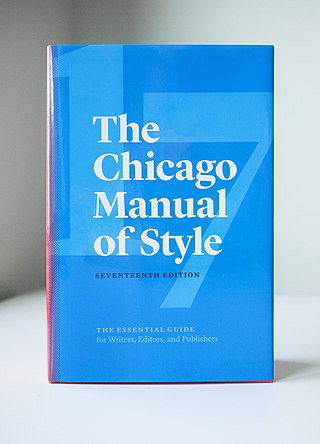
The Chicago Manual of Style is a style guide for American English published since 1906 by the University of Chicago Press. Its 17 editions have prescribed writing and citation styles widely used in publishing.
Webster's Dictionary is any of the English language dictionaries edited in the early 19th century by Noah Webster (1758–1843), an American lexicographer, as well as numerous related or unrelated dictionaries that have adopted the Webster's name in his honor. "Webster's" has since become a genericized trademark in the United States for English dictionaries, and is widely used in dictionary titles.
The World Book Encyclopedia is an American encyclopedia. World Book was first published in 1917. Since 1925, a new edition of the encyclopedia has been published annually. Although published online in digital form for a number of years, World Book is currently the only American encyclopedia which also still provides a print edition. The encyclopedia is designed to cover major areas of knowledge uniformly, but it shows particular strength in scientific, technical, historical and medical subjects.

The Newberry Library is an independent research library, specializing in the humanities and located on Washington Square in Chicago, Illinois. It has been free and open to the public since 1887. Its collections encompass a variety of topics related to the history and cultural production of Western Europe and the Americas over the last six centuries. The Library is named to honor the founding bequest from the estate of philanthropist Walter Loomis Newberry. Core collection strengths support research in several subject areas, including maps, travel, and exploration; music from the Renaissance to the early twentieth century; early contact between Western colonizers and Indigenous peoples in the Western Hemisphere; the personal papers of twentieth-century American journalists; the history of printing; and genealogy and local history.

The Associated Press Stylebook, alternatively titled The Associated Press Stylebook and Briefing on Media Law, is a style and usage guide for American English grammar created by American journalists working for or connected with the Associated Press journalism cooperative based in New York City. The Stylebook offers a basic reference to American English grammar, punctuation, and principles of reporting, including many definitions and rules for usage as well as styles for capitalization, abbreviation, spelling, and numerals.
Rand McNally is an American technology and publishing company that provides mapping, software and hardware for consumer electronics, commercial transportation and education markets. The company is headquartered in Chicago, with a distribution center in Richmond, Kentucky.
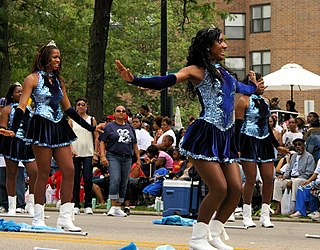
Washington Park is a community area on the South Side of Chicago which includes the 372 acre (1.5 km2) park of the same name, stretching east-west from Cottage Grove Avenue to the Dan Ryan Expressway, and north-south from 51st Street to 63rd. It is home to the DuSable Museum of African American History. The park was the proposed site of the Olympic Stadium and the Olympic Aquatics Center in Chicago's bid to host the 2016 Summer Olympics.

The Encyclopedia of Australian Rock and Pop or Rock and Pop by Australian music journalist Ian McFarlane is a guide to Australian popular music from the 1950s to the late 1990s. The book has a similar title to the 1978 work by Noel McGrath, Australian Encyclopaedia of Rock and Pop, but is not otherwise related.
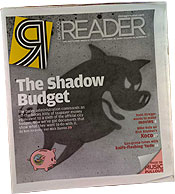
The Chicago Reader, or Reader, is an American alternative newspaper in Chicago, Illinois, noted for its literary style of journalism and coverage of the arts, particularly film and theater. The Reader has been recognized as a pioneer among alternative weeklies for both its creative nonfiction and its commercial scheme. Richard Karpel, then-executive director of the Association of Alternative Newsweeklies, wrote:
[T]he most significant historical event in the creation of the modern alt-weekly occurred in Chicago in 1971, when the Chicago Reader pioneered the practice of free circulation, a cornerstone of today's alternative papers. The Reader also developed a new kind of journalism, ignoring the news and focusing on everyday life and ordinary people.

Banglapedia:theNational Encyclopedia of Bangladesh is the first Bangladeshi encyclopedia. It is available in print, CD-ROM format and online, in both Bengali and English. The print version comprises fourteen 500-page volumes. The first edition was published in January 2003 in ten volumes by the Asiatic Society of Bangladesh, with a plan to update it every two years. The second edition was issued in 2012 in fourteen volumes.

Grolier was one of the largest American publishers of general encyclopedias, including The Book of Knowledge (1910), The New Book of Knowledge (1966), The New Book of Popular Science (1972), Encyclopedia Americana (1945), Academic American Encyclopedia (1980), and numerous incarnations of a CD-ROM encyclopedia (1986–2003).
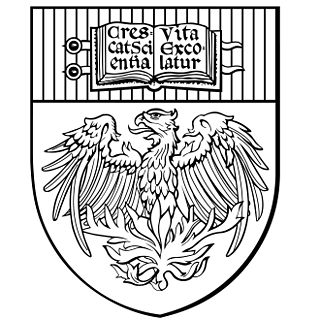
The University of Chicago Press is the largest and one of the oldest university presses in the United States. It is operated by the University of Chicago and publishes a wide range of academic titles, including The Chicago Manual of Style, numerous academic journals, and advanced monographs in the academic fields.

Webster's Third New International Dictionary of the English Language, Unabridged is an American English-language dictionary published in September 1961. It was edited by Philip Babcock Gove and a team of lexicographers who spent 757 editor-years and $3.5 million. The most recent printing has 2,816 pages, and as of 2005, it contained more than 476,000 vocabulary entries, 500,000 definitions, 140,000 etymologies, 200,000 verbal illustrations, 350,000 example sentences, 3,000 pictorial illustrations and an 18,000-word Addenda section.
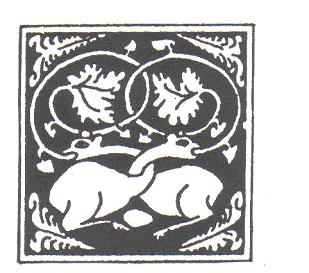
The Medieval Chronicle Society is an international and interdisciplinary organization founded to facilitate the work of scholars interested in medieval annals and chronicles, or more generally medieval historiography. It was founded in 1999 and in February 2011 had 380 members.
The Pennsylvania Sumerian Dictionary (PSD) is a project to compile a comprehensive dictionary of the Sumerian language. It is run out of the University of Pennsylvania's Museum of Archaeology and Anthropology and funded by both private donors and the National Endowment for the Humanities. The project began under the direction of Åke W. Sjöberg (1924–2014) and Erle Leichty in 1974 and was modeled on the Chicago Assyrian Dictionary, itself begun in 1921. In 1976 it received its first federal funds from the National Endowment for the Humanities, and in 1984 published its first section for the letter B; only 750 copies were originally printed, but more were soon published as the first batch sold out surprisingly quickly at US$40 a piece. As of 1989 Sjöberg was still project director, and despite retiring in 1996 continued to contribute.
The Jargon File is a glossary and usage dictionary of slang used by computer programmers. The original Jargon File was a collection of terms from technical cultures such as the MIT AI Lab, the Stanford AI Lab (SAIL) and others of the old ARPANET AI/LISP/PDP-10 communities, including Bolt, Beranek and Newman, Carnegie Mellon University, and Worcester Polytechnic Institute. It was published in paperback form in 1983 as The Hacker's Dictionary, revised in 1991 as The New Hacker's Dictionary.
Tennessee Encyclopedia is a reference book on the U.S. state of Tennessee that was published in book form in 1998 and has also been available online since 2002. Contents include history, geography, culture, and biography.
The Global Arabic Encyclopedia is an encyclopedic reference work written in the Arabic language. It is in part a translation of the American World Book Encyclopedia, edited and expanded to reflect an Arab–Muslim perspective. Its composition and publication were funded by Sultan bin Abdulaziz, Crown Prince of Saudi Arabia.
